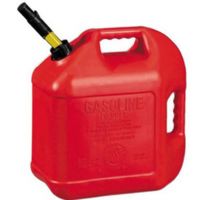Many of us keep plastic gas cans in our garage or storage sheds. Unfortunately, most  plastic gas cans are made without a safety feature known as a flame arrestor. The lack of a flame arrestor on a plastic gas can creates a dangerous condition, which could result in the gas exploding.
plastic gas cans are made without a safety feature known as a flame arrestor. The lack of a flame arrestor on a plastic gas can creates a dangerous condition, which could result in the gas exploding.
In a widely reported case, 3 year old Landon Beadore was helping his mother pick up toys in a storage cellar when he accidently knocked over a plastic gas can like the one pictured here. Vapors from the gas can went along the floor, and the pilot light on a nearby water heater ignited the fumes. The gas fumes flashed back to the nozzle of the gas can, causing it to explode and burning Landon over 47% of his body. Landon’s shoes literally melted onto his feet.
Tragedies similar to Landon’s have occurred more than 75 times across the United States, burning and killing children, teenagers and adults. Nearly 40% of the victims were children. Manufacturing experts and victims’ lawyers in these cases believe that a small part known as a flame arrestor, which costs less than $1, could have prevented these horrible injuries. Regrettably, despite evidence that these plastic gas containers are more prone to explosions, the manufacturers of the containers and the Consumer Product Safety Commission have not required the installation of flame arrestors on plastic containers or warned consumers of this potentially dangerous defect. Ironically, as far back as 1973, Consumer Reports magazine wrote: “Should fumes outside the gas can ignite as you pour or fill, a flash back fire is possible that could ignite the contents of the can itself. Such accidents can be prevented by a flame arrestor, which we think should be legally required in all openings like these.”
These tragic situations have come to light recently, but for a different reason than you would expect. A series of attacks have been launched by big business and tort reformers against victims’ lawyers and their clients as part of a propaganda campaign. Blitz USA, America’s largest plastic gas can manufacturer, recently announced that it is closing its factory after nearly 50 years in operation. The reason, the company claimed, is unwarranted products liability litigation. Blitz USA and other companies in the gas can manufacturing industry are blaming victims for their “ignorance” in causing or contributing to the cause of plastic gas can explosions. They cite “consumer misuse” as the main cause of these types of accidents. Rob Jakobe, another victim, disagrees. Mr. Jakobe was walking with a Blitz gas can on a crisp day in Oregon when a static electric discharge from his body caused the can to explode. Chad Funchess, another victim, was filling up his chainsaw when his Blitz gas can erupted and engulfed him in flames. William Melvin, yet another victim, was refueling his lawnmower when his Blitz gas can exploded and hurled him through his barn.
It’s regrettable that big business, including the U.S. Chamber of Commerce, is standing behind Blitz USA and other manufacturers of similar plastic gas cans despite the horrific burning injuries and deaths of more than 75 citizens. How many more people will be burned or killed before these gas cans are pulled off the market? In the meantime, consumers should consider buying a gas can with a flame arrestor. These cans are sometimes called “safety cans,” and are normally made of metal rather than plastic. Additionally, never forget how dangerous it is to use or store gasoline. Consider the following safety tips:
– Keep gasoline out of sight and secured away from children.
– Do not let children handle gasoline.
– Store gasoline in a safety can outside the home, such as in a detached garage or storage shed.
– Do not use or store gasoline near potential ignition sources, such as electrical devices or any device that contains a pilot light or spark.
– Never use gasoline inside the home or as a cleaning agent.
– Do not use gasoline to accelerate a flame on a charcoal grill, wood stove, brush fire or campfire.
– Do not smoke when handling gasoline.
Continue reading ›
 Georgia Injury Lawyer Blog
Georgia Injury Lawyer Blog











 Hospital acquired infections (HAI), also known as “healthcare-associated infections” or “nosocomial” infections, are infections that patients get while undergoing medical treatment in healthcare facilities. They are infections that are not present and without evidence of incubation at the time the patient is admitted to a healthcare facility. Most infections that become clinically evident after 48 hours of a patient’s hospitalization are considered hospital acquired. These infections occur in all types of medical facilities, including hospitals, outpatient surgical and care centers, and long-term care facilities, such as nursing homes and rehabilitation centers.
Hospital acquired infections (HAI), also known as “healthcare-associated infections” or “nosocomial” infections, are infections that patients get while undergoing medical treatment in healthcare facilities. They are infections that are not present and without evidence of incubation at the time the patient is admitted to a healthcare facility. Most infections that become clinically evident after 48 hours of a patient’s hospitalization are considered hospital acquired. These infections occur in all types of medical facilities, including hospitals, outpatient surgical and care centers, and long-term care facilities, such as nursing homes and rehabilitation centers.  As our population continues to age, most of us will eventually face the prospect of placing a loved one into institutional care. Traditionally that has meant a nursing home. In the last ten to fifteen years, however, the growth of the assisted living industry has created an alternative to nursing home placement. So which is right for you and your family?
As our population continues to age, most of us will eventually face the prospect of placing a loved one into institutional care. Traditionally that has meant a nursing home. In the last ten to fifteen years, however, the growth of the assisted living industry has created an alternative to nursing home placement. So which is right for you and your family? Manufactured by Takeda Pharmaceutical Company Limited and co-marketed in the United States by Eli Lilly and Company, Actos is a medication that is prescribed with diet changes and exercise to help regulate blood sugars for patients suffering from Type II diabetes. Prescribed in a daily 15 mg, 30 mg or 45 mg dose, Actos helps the body to be more efficient in its production, breakdown and absorption of blood sugars. When a person has too much blood sugar, the blood may become toxic to the organs, which are unable to use the sugar as fuel. Actos helps the muscles use insulin to absorb the needed sugar and keeps the liver from overproducing sugar. The Food and Drug Administration (FDA) has issued a
Manufactured by Takeda Pharmaceutical Company Limited and co-marketed in the United States by Eli Lilly and Company, Actos is a medication that is prescribed with diet changes and exercise to help regulate blood sugars for patients suffering from Type II diabetes. Prescribed in a daily 15 mg, 30 mg or 45 mg dose, Actos helps the body to be more efficient in its production, breakdown and absorption of blood sugars. When a person has too much blood sugar, the blood may become toxic to the organs, which are unable to use the sugar as fuel. Actos helps the muscles use insulin to absorb the needed sugar and keeps the liver from overproducing sugar. The Food and Drug Administration (FDA) has issued a  As reported by the
As reported by the